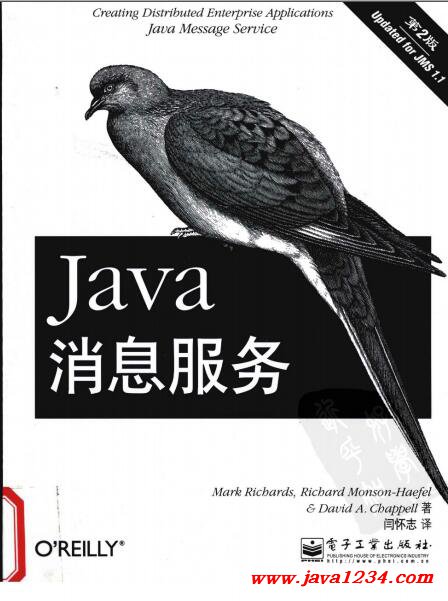| 失效链接处理 |
|
java消息服务(第二版)PDF 下载
转载自:http://download.csdn.net/detail/machen_smiling/9738839
本站整理下载:
版权归出版社和原作者所有,链接已删除,请购买正版
用户下载说明:
电子版仅供预览,下载后24小时内务必删除,支持正版,喜欢的请购买正版书籍:
http://product.dangdang.com/20802515.html
相关截图:

资料简介:
《Java消息服务》第二版,是对标准API的一个彻底详尽的介绍——它支持消息传递,即网络计算机间的关键数据从软件到软件的交换。你将学习到JMS如何帮助你解决许多架构难题,如整合不同的系统和应用程序,增加可扩展性,消除系统瓶颈,支持并行处理,提升灵活性和敏捷性。由于更新了JMS 1.1,第二版还说明了厂商无关的规范将有助于你写基于messaging的应用程序,无论是使用IBM的MQ、Progress软件的SonicMQ、ActiveMQ的,还是其他专有的消息服务。
有了《Java消息服务》,你将可以: 使用点对点和出版与订阅消息传递模型建立应用程序 使用如事务和持久订阅功能,以使应用程序可靠 使用消息驱动的beans在Enterprise JavaBeans(EJB)中实现消息传递 使用JMS时结合RESTful应用程序和Spring应用程序框架 消息传递是一个强大的范例,可以更容易地使企业应用程序的不同部分分离。《Java消息服务》第二版将迅速教会你如何运用其背后的关键技术。
资料目录:
Foreword Preface 1. Messaging Basics The Advantages of Messaging Heterogeneous Integration Reduce System Bottlenecks Increase Scalability Increase End User Productivity Architecture Flexibility and Agility Enterprise Messaging Centralized Architectures Decentralized Architectures Hybrid Architectures Centralized Architecture As a Model Messaging Models Point-to-Point Publish-and-Subscribe JMS API Point-to-Point API Publish-and-Subscribe API Real-World Scenarios Service-Oriented Architecture Event-Driven Architecture Heterogeneous Platform Integration Enterprise Application Integration Business-to-Business Geographic Dispersion Information Broadcasting Building Dynamic Systems RPC Versus Asynchronous Messaging Tightly Coupled RPC Enterprise Messaging 2. Developing a Simple Example The Chat Application Getting Started with the Chat Example Examining the Source Code Sessions and Threading 3. Anatomy of a JMS Message Headers Automatically Assigned Headers Developer-Assigned Headers Properties Application-Specific Properties JMS-Defined Properties Provider-Specific Properties Message Types Message TextMessage ObjectMessage BytesMessage StreamMessage MapMessage Read-Only Messages Client-Acknowledged Messages Interoperability and Portability of Messages 4. Point-to-Point Messaging Point-to-Point Overview When to Use Point-to-Point Messaging The QBorrower and QLender Application Configuring and Running the Application The QBorrower Class The QLender Class Message Correlation Dynamic Versus Administered Queues Load Balancing Using Multiple Receivers Examining a Queue 5. Publish-and-Subscribe Messaging Publish-and-Subscribe Overview When to Use Publish-and-Subscribe Messaging The TBorrower and TLender Application Configuring and Running the Application The TLender Class The TBorrower Class Durable Versus Nondurable Subscribers Dynamic Versus Administered Subscribers Unsubscribing Dynamic Durable Subscribers Temporary Topics 6. Message Filtering Message Selectors Identifiers Literals Comparison Operators Arithmetic Operators Declaring a Message Selector Message Selector Examples Managing Claims in an HMO Notification of Certain Bids on Inventory Priority Handling Stock Trade Order Auditing Not Delivered Semantics Design Considerations 7. Guaranteed Messaging and Transactions Guaranteed Messaging Message Autonomy Store-and-Forward Messaging Message Acknowledgments and Failure Conditions Message Acknowledgments AUTO_ACKNOWLEDGE DUPS_OK_ACKNOWLEDGE CLIENT_ACKNOWLEDGE Message Groups and Acknowledgment Handling Redelivery of Messages in an Application Message Groups Example Message Grouping and Multiple Receivers Transacted Messages Creating and Using a JMS Transaction Transacted Session Example Distributed Transactions Lost Connections The ExceptionListener Example Dead Message Queues 8. Java EE and Message-Driven Beans Java EE Overview Enterprise JavaBeans Enterprise JavaBeans 3.0 (EJB3) Overview Simplified Bean Development Dependency Injection Simplified Callback Methods Programmatic Defaults Interceptors Java Persistence API JMS Resources in Java EE The JNDI Environment Naming Context (ENC) Message-Driven Beans Concurrent Processing and Scalability Defining Message-Driven Beans Message-Driven Bean Use Cases Message Facade Transformation and Routing 9. Spring and JMS Spring Messaging Architecture JmsTemplate Overview Send Methods convertAndSend Methods receive and receiveSelected Methods receiveAndConvert Methods Connection Factories and JMS Destinations Using JNDI Using Native Classes Sending Messages Using the send Method Using the convertAndSend Method Using a Nondefault JMS Destination Receiving Messages Synchronously Message-Driven POJOs The Spring Message Listener Container MDP Option 1: Using the MessageListener Interface MDP Option 2: Using the SessionAwareMessageListener Interface MDP Option 3: Using the MessageListenerAdapter Message Conversion Limitations The Spring JMS Namespace [jms:listener-container] Element Properties [jms:listener] Element Properties 10. Deployment Considerations Performance, Scalability, and Reliability Determining Message Throughput Requirements Testing the Real-World Scenario To Multicast or Not to Multicast TCP/IP UDP IP Multicast Messaging Over IP Multicast The Bottom Line Security Authentication Authorization Secure Communication Firewalls and HTTP Tunneling Connecting to the Outside World Bridging to Other Messaging Systems 11. Messaging Design Considerations Internal Versus External Destination Internal Destination Topology External Destination Topology Request/Reply Messaging Design Messaging Design Anti-Patterns Single-Purpose Queue Message Priority Overuse Message Header Misuse A. The Java Message Service API B. Message Headers C. Message Properties D. Installing and Configuring ActiveMQ Index |




 苏公网安备 32061202001004号
苏公网安备 32061202001004号



